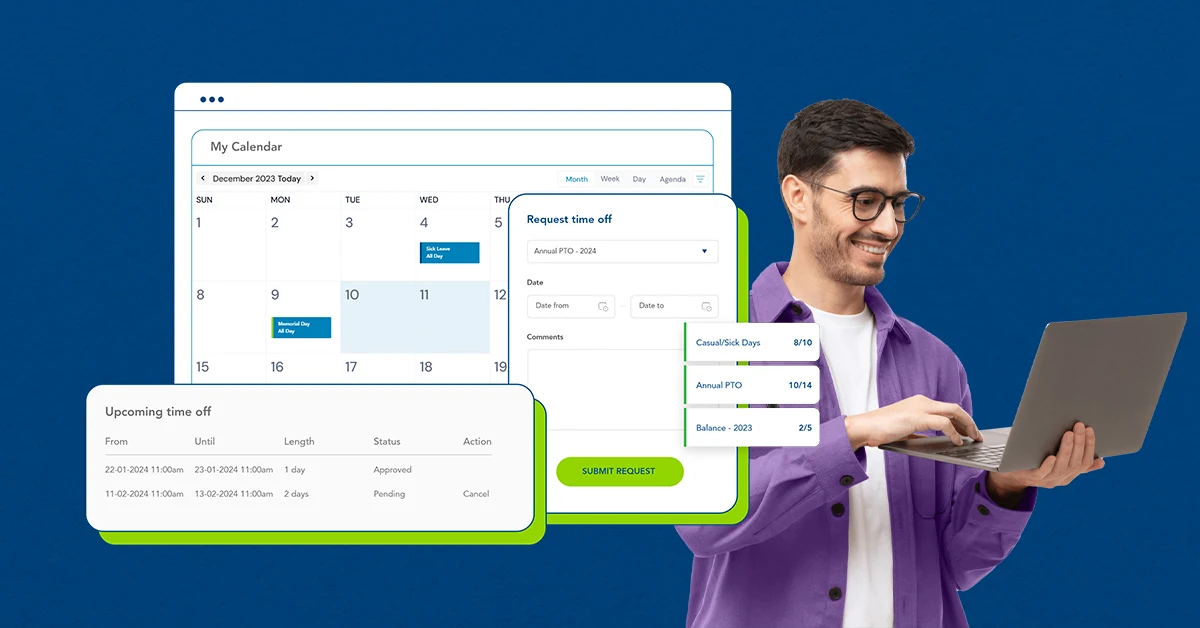Employees are the backbone of any organization, and each of their contributions has an essential role in its success. However, unexpected situations may come up that require their attention outside of work, and it’s important that they feel supported and respected during this time.
One way to show you care about their well-being is by having employee leave of absence policies in place. That way, they know what to expect if an unforeseen circumstance arises, and you have the operational processes in place to give them the time they need.
With an effective leave management process, you can accommodate the needs of your employees while maintaining operational efficiency and staying in compliance with labor laws, collective bargaining agreements (CBAs), and internal policies. It starts with developing an in-depth understanding of leaves of absence so you can create an approach that works best for your organization and team. Then, you can determine the resources you need to streamline implementation and manage your process effectively.
Let’s take an in-depth look at leaves of absence, including what they are, their purposes and types, and reasons to grant them.
What is a leave of absence?
A leave of absence is a period of time an employee takes off work, typically to attend to an unplanned or urgent circumstance. It differs from paid time off (PTO) or vacation time, which an employee can accrue time for and plan in advance.
Some reasons employees might take a leave of absence include personal or family health issues, military deployment, or bereavement. Leaves of absence may be paid or unpaid, depending on factors such as whether they are mandatory or voluntary.
How long can leaves of absence last?
Depending on the type, a leave of absence length can range from days (voting), weeks (FMLA), months (ADA), or even years (military). Let’s explore the differences between mandatory and voluntary leave to see why there’s no set time for a leave of absence.
Mandatory leave of absence vs. voluntary leave of absence
A mandatory leave of absence is regulated by federal, local, and state laws. It requires the employee to meet specific eligibility criteria and determines the responsibilities the employer has to the employee regarding their time off.
While federal laws pertaining to mandatory leaves of absence don’t require paid leave, some state laws obligate employers to pay employees in some instances. These federal laws guarantee employees’ rights to take a leave of absence:
- Family Medical Leave Act (FMLA): Under the FMLA, eligible employees can take up to 12 workweeks of leave in a 12-month period to care for an ill family member, a personal health condition, or a newborn, foster child, or adopted child. If the employee cares for a family member whose condition resulted from active military service, the employee can take up to 26 workweeks off in a 12-month.
- Americans with Disabilities Act (ADA): The ADA mandates that employers grant reasonable accommodations—which may include leaves of absence—to employees who have substantial limitations in or more major life activities due to a mental or physical impairment. The length of leave an employee receives under the ADA depends on their job, condition, and individual circumstances.
- ADA Amendments Act (ADAAA): In 2008, Congress passed the ADAAA to expand on ADA protections by broadening the definition of “disability” and making eligibility criteria less restrictive. Under the ADAAA, employees not covered under the original ADA legislation may have the right to take a leave of absence as a reasonable accommodation.
- Uniformed Services Employment and Reemployment Rights Act (USERRA): USERRA requires employers to reinstate the jobs and benefits of active and Reserve members of the United States Armed Forces upon their return from military service. Under this law, Veterans and Reserve members have a right to reemployment, freedom from discrimination and retaliation, and health insurance protection.
A voluntary leave of absence isn’t subject to federal, state, or local laws. Except when CBAs are required, employers can decide whether to offer voluntary leaves of absence. Voluntary leave is typically unpaid, so employees usually take it for emergencies, although some organizations allow voluntary leaves of absence for personal reasons as well. Employers aren’t required to reinstate employees’ positions after a voluntary leave.
What are protected leaves of absence?
Any leave that employers must provide to employees with the guarantee that the employee can keep their job is considered a protected leave of absence. This includes those covered by both federal and state law. Examples of protected leave include:
- Military service: Under USERRA, Veterans and Reserve members must receive the same pay, seniority, and status as they retained prior to their military leave. Individual states also have laws regarding the employment rights of their National Guard members, including whether their leave must be paid if they’re called to active duty.
- Voting: With the exception of federal employees, employees don’t have guaranteed time off to vote in elections. However, many state laws require employers to allow paid or unpaid leave—typically up to a certain number of hours—to vote in federal, state, and/or local elections.
- Jury duty: Federal law requires employers to provide employees with leave for jury duty, but under the Fair Labor Standards Act (FLSA), it doesn’t require the leave to be paid. Some state laws mandate paid leave for employees on jury duty or forbid employers from forcing employees to use personal leave for jury duty.
Some protected leaves of absence, such as military service and jury duty, are mandatory for employers to provide and for employees to take. Others, such as voting and medical leave, are optional for employees but mandatory for employers to grant.
Who qualifies for leave under the Family and Medical Leave Act (FMLA)?
One of the most common leaves of absence employees take is an FMLA leave. The FMLA offers eligible employees up to 12 weeks of unpaid leave or up to 26 weeks of Military Caregiver Leave with continuation of group health benefits. To be eligible, an individual must:
- Work for a public agency, an educational institution, or an organization that employs at least 50 people within a 75-mile radius
- Have worked for their employer for at least 12 months
- Have worked at least 1,250 hours for their employer within the past 12 months
The complexity of FMLA leaves and other employee leaves of absence makes them challenging to manage. Many organizations use leave management software to accommodate FMLA and different types of leave while maintaining accuracy, efficiency, and compliance. While FMLA is strictly for medical leave, employers can approve a voluntary leave of absence for varying reasons.
Reasons employees request a leave of absence
Employees sometimes request voluntary leaves of absence for personal reasons or if they don’t qualify for mandatory leave. These are usually unpaid, but some employers offer paid voluntary leave as an organizational policy or on a case-by-case basis. Reasons employees might ask an employer for a leave of absence include:
- Sabbaticals
- Continuing education
- Professional development
- Caregiver duties, mainly if the employee isn’t yet eligible for mandatory leave
- Medical reasons not covered by the FMLA or ADA
- Personal reasons
Maintaining a clear leave of absence procedure enables you to stay updated on your organization’s offerings so you know how to address employee leave requests. The right policies reflect the needs of your organization and employees, and the right leave management system can manage those policies seamlessly.
Reasons for granting a voluntary leave of absence
Choosing to offer employees voluntary leaves of absence makes them feel respected because it shows them that you care about their work-life balance. This promotes overall well-being, job satisfaction, and workplace morale.
Consider creating policies on approved circumstances for taking a voluntary leave. Include rules regarding how long employees can take off and whether it’s paid or unpaid so you can align your organizational needs with the needs of your employees. Then, you can streamline the process with a leave management platform configured to your organization’s distinct requirements.
Extending an employee leave of absence
Organizations can choose whether to extend any leave of absence at their discretion. If an employer grants an employee a leave extension after the eligibility period for mandatory leave ends, the mandatory leave protections for the employee no longer apply.
Although you can establish your own terms for extending the leave, it’s best to check with your HR and legal teams before deciding whether to grant an extension. Understanding how, when, and why to approve and extend leaves of absence can help you develop your organization’s best leave management process.
Automate your leave management process with TCP Software
Regardless of your organization’s policies regarding leaves of absence, it’s critical to have an effective leave management system in place. A structured process can help you prepare for the potential of mandatory leave and maintain consistent rules around voluntary leave.
This is crucial not only for operational efficiency but also for the employee experience. When employees know how your organization handles leaves of absence, they can trust that your process is fair and know what to expect if they need to take time off.
Part of an effective leave management system is the ability to maintain accurate policies and records. This can challenge even the most experienced HR professionals, as the labor laws, CBAs, and internal policies about leaves of absence are often complex and challenging to maintain with manual or unspecialized systems.
If mishandled, employers can face costly legal penalties and employee retention issues that hurt their bottom lines. TCP Software’s leave management solutions help organizations across industries implement and maintain accurate, efficient leave management processes with features like:
- Configuration based on organizational policies, federal and state laws, and CBAs
- Flexible tracking for different types of leave, such as FMLA and jury duty
- A dedicated FMLA module
- Automated request tracking and request notifications with one-click request approval
TCP Software’s employee scheduling and time and attendance solutions have the flexibility and scalability to suit your business and your employees, now and as you grow.
From TimeClock Plus, which automates even the most complex payroll calculations and leave management requests, to Humanity Schedule for dynamic employee scheduling that saves you time and money, we have everything you need to meet your organization’s needs, no matter how unique. Plus, with Aladtec, we offer 24/7 public safety scheduling solutions for your hometown heroes.
Ready to learn how TCP Software takes the pain out of employee scheduling and time tracking? Speak with an expert today.





